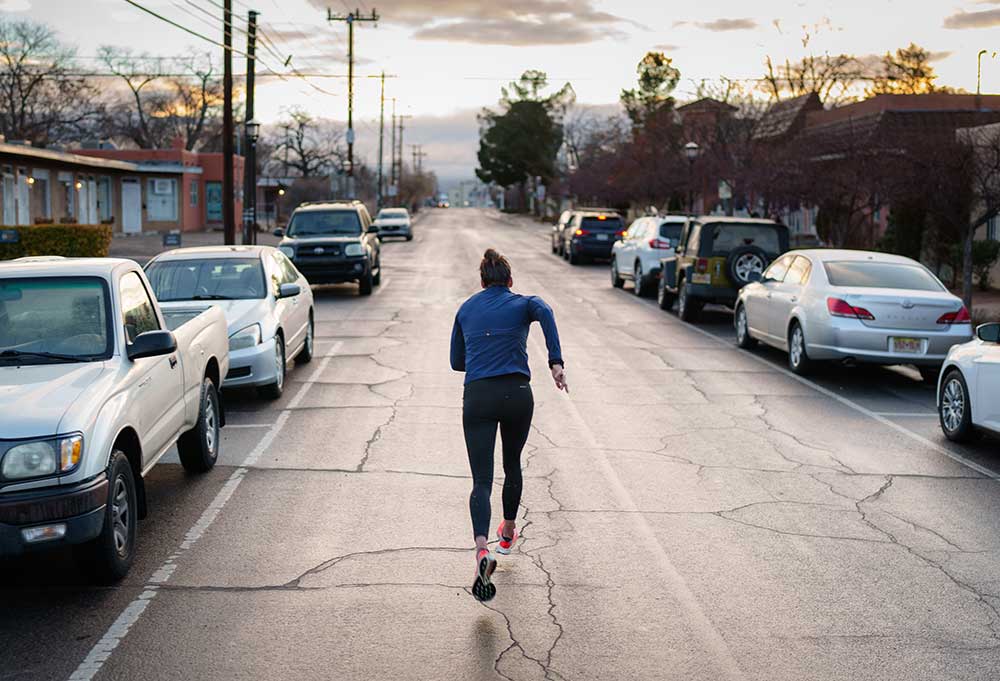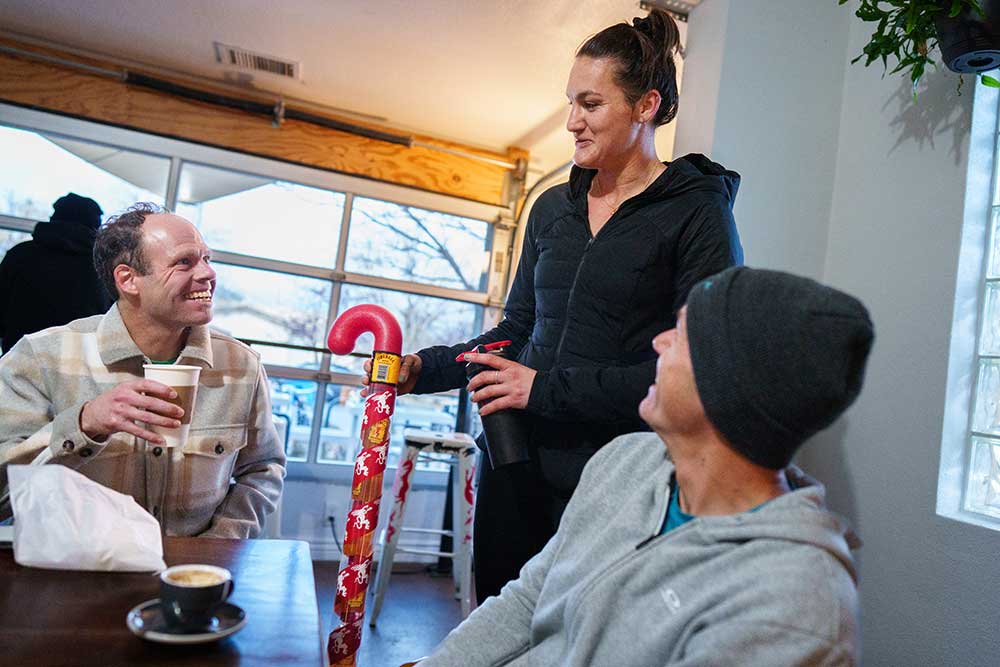Sandia engineer won’t be going to the Olympics … yet

The day of the race, Sofie Schunk laced up her shoes knowing it wasn’t her day to break any records. But 8-year-old Ila Gray was there on the sidelines waiting to cheer Sofie on with a hand drawn sign that read, “Go Sofie Our Type 1 HERO.”
Sofie was in Orlando to compete alongside dozens of full-time professional runners, all vying for a seat on the 2024 U.S. Olympic Marathon Team. And as expected, it wasn’t her day. The women’s qualifying time is 2:26:50, Sofie finished in 3:22:26, 117 out of 117 finishers. Or as she describes it, “dead last.”
“It was my slowest marathon,” said Sofie, a Sandia systems engineer.
Sofie has been running marathons since 2016 and living with Type 1 diabetes since 2008.
The diagnosis
The latter came down her sophomore year of high school. Always an active kid, Sofie played soccer and ran track, but after a family vacation started experiencing weird symptoms. First it was a head-to-toe rash, next she was losing weight with no explanation, coupled with depleting energy, Sofie was suddenly falling asleep in class and feeling constantly exhausted.
“My mom took me to the doctor, and they said maybe I was just growing,” Sofie said. “But they did blood work and when my labs came back the doctor called my mom panicked and was like, ‘get her to the hospital now!’”
The doctor was worried Sofie was in diabetic ketoacidosis which is what happens when the body doesn’t have enough insulin to allow blood sugar into the cells to use as energy. This causes the liver to break down fat for fuel which produces acids called ketones and when too many ketones are produced too fast, it can be toxic.
Sofie’s blood sugar was 680 milligrams per deciliter. Normal blood sugar range should be within 90 to 130.
“Initially, after learning I was Type 1, I felt relieved to finally have a reason for why I was feeling so terrible,” Sofie said. “I went home that night and ate a pear, took my insulin and my blood sugar still went up to around 400.”
“That’s when it hit me — shots multiple times a day, monitoring my blood sugar, this was the rest of my life,” Sofie said. “I just started to cry.”
Living with Type 1
Sofie said the first year after the diagnosis was the hardest. She had always been shy but now she had to take shots in front of people and started gaining weight — which she knows now was healthy — but the adjustment was tough.
She continued playing soccer and running track as a sprint and mid-distance runner, but at much slower speeds.
In the fall of 2010, Sofie started at Marquette University where she continued playing NCAA Division I soccer as the team’s goalie for four years. It was here where she met other athletes living with Type 1 diabetes.
“I met Patrick Maag, who was on the track and cross-country team at Marquette,” Sofie said. “He was diagnosed as a child and talked to me about what devices he used, how he managed his diet, when he’d take his insulin and how he’d fuel before and after exercise.”
Maag encouraged Sofie to pursue a degree in exercise science where she met John Kilka, a faculty member, who had been diagnosed with Type 1 diabetes later in life.
“He had run an Iron Man before he developed diabetes and then again after he was diagnosed,” Sofie said. “Patrick and John showed me that running long distances with Type 1 was possible.”
Going the distance with Type 1 diabetes
And so Sofie started running.
Encouraged by John, Sofie joined the “Running with the President” run club at Marquette. But learning to navigate longer distances while managing her diabetes wasn’t without its challenges.
“The first time I ran more than 10 miles, I had to stop at a gas station and explain to the attendant that I was diabetic, and my blood sugar was dropping, but I didn’t have any money, so they ended up giving me a Gatorade,” Sofie said. “I went back and paid later but the experience really opened my eyes to how prepared I needed to be for everything.”
In 2016, Sofie ran her first marathon.

“I had never planned on running a marathon, but I was training with a group that was running the Lakefront Marathon in Milwaukee, and they encouraged me to sign up for my first half, which I did and had such a great time,” Sofie said. “And they were like, ‘you should just run the full,’ and so I did.”
Sofie ran a 2:52 and placed third.
“I had a really good day,” Sofie said. “I discovered my love of distance running and had mastered my blood sugar. I was ready for the next one.”
But like all things in life, they weren’t all good days. Although as Sofie explains, each setback was set up for comeback.
“I ran Boston in 2018 but I overtrained and kept getting stress fractures,” Sofie said. “The day of the race was rough. I didn’t do great, but I learned an important lesson about training and just how humbling running a marathon can be.”
Running toward the Olympics
The next few years brought a move to San Diego and then back home to Albuquerque. More injuries and setbacks, a marathon personal best, a break from long distances, a global pandemic and then a return to long distance.
In January of 2023, Sofie ran a 1:16 half marathon, shaving four minutes off her previous record of 1:20.
“I texted my coach and asked what that translates to in marathon time,” Sofie said. “And he told me, ‘I think you could qualify for trials,’” which began the journey to break the 2:37 qualifying time, requiring a 12-minute record from her previous best.
Sofie and her coach put a plan in place and started training. This time for the Olympic Trials.
In October, Sofie ran a marathon in New York but missed the qualifying time by six minutes.
“I was disappointed. I had a perfect training block and during the race I felt great until mile 18 or so, and then I started cramping,” Sofie said. “My blood sugars were really high and so after the race, I had to go back to the drawing board with my endocrinologist and medical team.”
Sofie ended up filing a Therapeutic Use Exemption so that she could use insulin during competitions. Insulin is currently a banned substance for professional athletes, even for Type 1 diabetics like Sofie.
Two months later Sofie ran the California International Marathon where she qualified for the Olympic Trials running a 2:36:22. Another personal best by six minutes.
The Olympic Trials
In the week leading up to Orlando, Sofie had been dealing with on-going shin pain that she was hoping would resolve itself. But the night before the race, still in pain, Sofie found herself almost in tears wondering if she should even start the race, let alone try to finish.
“I talked to my friend who coaches professionally and asked what I should do,” Sofie said. “He reminded me I had nothing to lose. Worst case, I would be in a lot of pain and wouldn’t be able to finish.”
And then there was Ila, the 8-year-old girl waiting to cheer Sofie on with her handrawn sign, and so many others living with Type 1 diabetes that had reached out to Sofie, their Type 1 hero, who believed in her and were excited to watch her run.
On race day, Sofie wrote in an Instagram post that she “celebrated the first step in a dream, lining up with the best runners in the U.S. after a year of work and dedication,” and she ran.
“It may have not been my day to race against those competitors, but it was my day to show up, finish and inspire other kids, parents and anyone living with diabetes that we don’t have to let this disease stop us,” Sofie said. “We can go out there with grace and try even if we don’t always get the outcome we want. We can’t quit.”
Sofie won’t be going to the Olympics quite yet. But if her story tells us anything it’s that her “slowest marathon ever” is likely just the kickoff to her next personal best.